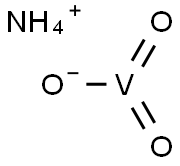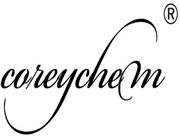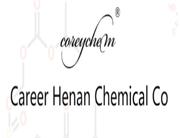| Description |
Ammonium metavanadate can be used as a catalyst for organic synthesis. Thermal decomposition of ammonium metavanadate yields vanadium pentoxide, V205, which is widely used as catalyst and precursor for other vanadium compounds and metallic vanadium itself. Ammonium metavanadate is a reagent in the analytical chemistry and a developer in the photography industry. Ammonium metavanadate is used in dyeing and printing in the textile industry. Ammonium metavanadate is also used as dryer for paints. |
| References |
[1] Kirti S.Niralwad, Bapurao B.Shingate and Murlidhar S.Shingare, Microwave-assisted one-pot synthesis of octahydroquinazolinone derivatives using ammonium metavanadate under solvent-free condition, Tetrahedron Letters, 2010, vol. 51, 3616-3618
[2] Ganesh R. Jadhav, Mohammad U. Shaikh, Rajesh P. Kale, Charansingh H. Gill, Ammonium metavanadate: A novel catalyst for synthesis of 2-substituted benzimidazole derivatives, Chinese Chemical Letters, 2009, vol. 20, 292-295
[3] Swapnil S. Sonar, Amol H. Kategaonkar, M. N. Ware; Charansingh H. Gill, Bapurao B. Shingate and Murlidhar S. Shingare, Ammonium metavanadate: an effective catalyst for synthesis of α-hydroxyphosphonates, ARKIVOC, 2009, vol. 2009, 138-148
[4] Klaus-Jürgen Range and Reinhard Zintl, The thermal decomposition of ammonium metavanadate (V) in open and closed systems, Zeitschrift für Naturforschung B, 1988, vol.43, 309-317
[5] Jeanne Mager Stellman, Encyclopaedia of Occupational Health and Safety: Chemical, Industries and Safety, 2012
[6] NPCS Board of Consultants & Engineers, Selected Formulary Book on Inks, Paints, Lacquers, Varnishes and Enamels, 2007 |
| Chemical Properties |
white or slightly yellow powder or crystals |
| Uses |
Used in combustion analysis of carbon, hydrogen, and nitrogen |
| Uses |
In dyeing and printing on woolens; staining wood black; manufacture of vanadium black and "indelible ink"; producing vanadium luster on pottery; as photographic developer; in hematoxylin staining in microscopy; as reagent in analytical chemistry. |
| General Description |
A white crystalline powder. Slightly soluble in water and denser than water. Decomposes at 410°F. May release toxic fumes. Moderately toxic. An irritant. Used as a dryer for paints and inks, and for dyes. Loses ammonia upon heating. |
| Air & Water Reactions |
Slightly soluble in water. |
| Reactivity Profile |
Acidic inorganic salts, such as Ammonium metavanadate, are generally soluble in water. The resulting solutions contain moderate concentrations of hydrogen ions and have pH's of less than 7.0. They react as acids to neutralize bases. These neutralizations generate heat, but less or far less than is generated by neutralization of inorganic acids, inorganic oxoacids, and carboxylic acid. They usually do not react as either oxidizing agents or reducing agents but such behavior is not impossible. Many of these compounds catalyze organic reactions. |
| Health Hazard |
TOXIC; inhalation, ingestion or skin contact with material may cause severe injury or death. Contact with molten substance may cause severe burns to skin and eyes. Avoid any skin contact. Effects of contact or inhalation may be delayed. Fire may produce irritating, corrosive and/or toxic gases. Runoff from fire control or dilution water may be corrosive and/or toxic and cause pollution. |
| Fire Hazard |
Non-combustible, substance itself does not burn but may decompose upon heating to produce corrosive and/or toxic fumes. Some are oxidizers and may ignite combustibles (wood, paper, oil, clothing, etc.). Contact with metals may evolve flammable hydrogen gas. Containers may explode when heated. |
| Safety Profile |
Poison by ingestion, subcutaneous, intravenous, intratracheal, and intraperitoneal routes. Moderately toxic by skin contact. An experimental teratogen. Other experimental reproductive effects. Mutation data reported. See also VANADIUM COMPOUNDS. When heated to decomposition it emits toxic fumes of NH3, VOx, and NOx. |
| Purification Methods |
Wash the salt with H2O until free from Cl-ions and dry it in air. It is soluble in H2O (5.18g/100mL at 15o, 10.4g/100mL at 32o) but is more soluble in dilute NH3. It crystallises from conductivity water (20mL/g). When heated at relatively low temperature, it loses H2O and NH3 to give vanadium oxide (V2O5), and at 210o it forms lower oxides. [Baker et al. Inorg Synth III 117 1950.] Its solubility in H2O is 0.52% (15o), 1% (32o) and 1.6% (50o). After washing the technical grade salt with H2O, it had Na, Mn and U at 0.06, 0.2 and 0.1 ppm, respectively. [Brauer in Handbook of Preparative Inorganic Chem (Ed. Brauer) Academic Press Vol II p 1272-1273 1965.] |

 China
China






